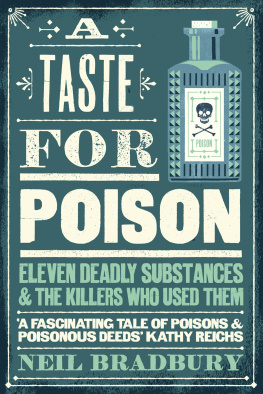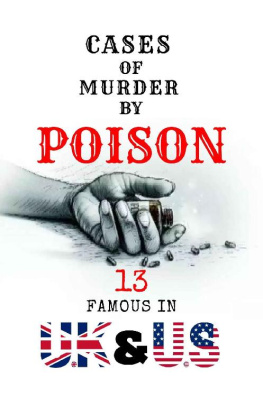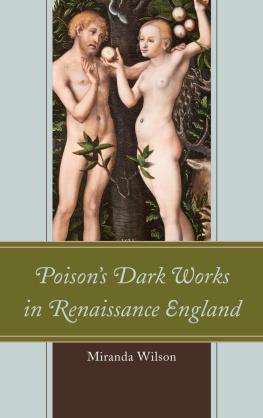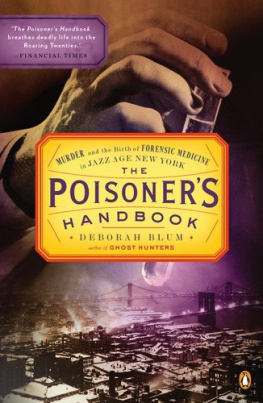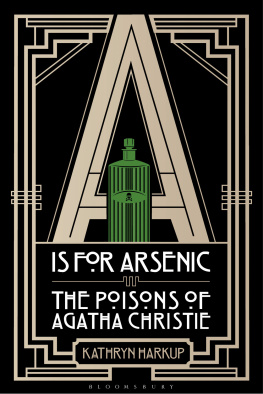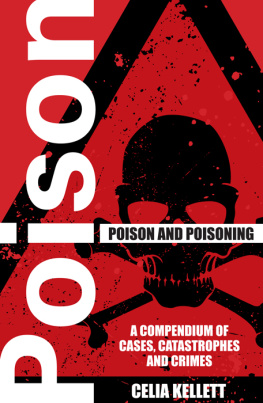POISON ROMANCE AND POISON MYSTERIES
* * *
C. J. S. THOMPSON
*
Poison Romance and Poison Mysteries
From a 1904 edition
ISBN 978-1-62013-858-8
Duke Classics
2014 Duke Classics and its licensors. All rights reserved.
While every effort has been used to ensure the accuracy and reliability of the information contained in this edition, Duke Classics does not assume liability or responsibility for any errors or omissions in this book. Duke Classics does not accept responsibility for loss suffered as a result of reliance upon the accuracy or currency of information contained in this book.
Contents
*
Preface to First Edition
*
IN response to the wishes of many who read this work when it appearedin serial form, it is now reproduced with much additional matter,which I hope may prove of value to those interested in the fascinatingsubject of poisons and the study of toxicology. It has been myendeavour to collect, in the following pages, the scattered fragmentsof historic and romantic lore connected with poisons from the earliestperiod, and to recount the stories of some notable "poison mysteries"of ancient and modern times. I am indebted to the works of Dr. WynterBlyth for many facts concerning the poisons of antiquity.
C. J. S. T.
1899
Preface to New Edition
*
IN presenting a new edition of this work to my readers, the opportunityhas been taken to introduce several new chapters, one of which dealswith the "poison mystery" which recently aroused such widespreadinterest in the United States. In response to suggestions, detailedaccounts of the "Horsford case" and the "Lambeth poison mysteries" havealso been added.
C. J. S. T.
Chapter I - Poisons of Antiquity
*
LONG before the action of vegetable and mineral substances on humanbeings and animals was known, it is probable that poisonous bodies insome form were used by primitive man.
When injured in battle by perhaps a flint arrow-head, or stone axe, hesought for something to revenge himself on his enemy. In his searchafter curative remedies he also found noxious ones, which producedunpleasant effects when applied to the point of a weapon destined toenter the internal economy of an opponent.
He doubtless also became aware that the spear-points and arrow-heads onwhich the blood of former victims had dried, caused wounds that rapidlyproved fatal, owing to the action of what we now call septic poisons.This probably led to experiments with the juices of plants, untilsomething of a more deadly character was discovered.
This was the very earliest age of poisoning, when pharmacy was employedfor vicious or revengeful purposes.
Thus we find that almost every savage nation and people has its ownpeculiar poison. In Africa the seeds of Strophanthus hispidus,or komb, a most virulent poison, are used for this purpose; whileexplorers tell us that the ancient pigmy race of Central Africa employa species of red ant crushed to a paste, to tip their arrows andspears. The South American Indians poison their arrow-heads with curareor ourari, produced from a species of strychnos and other plants,while the Malays and hill tribes of India use aconite, and otherpoisonous juices and extracts. The Antiaris toxicaria is also used asan arrow poison by the Malays.
The bushmen of the South African district "Kalahari," use the juiceof the leaf beetle "diamphidia" and its larva for poisoning theirarrow-heads. Lewin, who calls the beetle Diamphidia simplex, foundin its body, besides inert fatty acids, a toxalbumin which causesparalysis, and finally death. According to Boehm, the poison fromthe larva also belongs to the toxalbumins, and Starke states, thatit causes the dissolution of the colouring matter of the blood andproduces inflammation.
A halo of mystery, sometimes intermixed with romance, has hung aboutthe dread word poison from very early times. In the dark days ofmythology, allusions to mysterious poisons were made in legend andsaga. Thus a country in the Far North was supposed to be ruled anddominated by sorcerers and kindred beings, all of whom were said tobe children of the Sun. Here dwelt tes, Perses, Hecate, Medea,and Circe. Hecate was the daughter of Perses and married to tes,and their daughters were Medea and Circe. tes and Perses weresaid to be brothers, and their country was afterwards supposed tobe Colchis. To Hecate is ascribed the foundation of sorcery and thediscovery of poisonous herbs. Her knowledge of magic and spells wassupposed to be unequalled. She transmitted her power to Medea, whosewonderful exploits have been frequently described and depicted, andwho by her magic arts subdued the dragon that guarded the goldenfleece, and assisted Jason to perform his famous deeds. Hecate'sgarden is described by the poets as being enclosed in lofty walls withthrice-folding doors of ebony, which were guarded by terrible forms,and only those who bore the leavened rod of expiation and the concealedconciliatory offering could enter. Towering above was the temple ofthe dread sorceress, where the ghastly sacrifices were offered and allkinds of horrible spells worked.
Medea was also learned in sorcery and an accomplished magician. It isrelated that, after her adventures with Jason, she returned with him toThessaly. On their arrival they found son, the father of Jason, andPelias, his uncle, who had usurped the throne, both old and decrepit.Medea was requested to exert her magical powers to make the old manyoung again, an operation she is said to have speedily performed byinfusing the juice of certain potent plants into his veins.
Some years after, Medea deserted Jason and fled to Athens, and shortlyafterwards married geus, king of that city. geus had a son by aformer wife, named Theseus, who had been brought up in exile. At lengthhe resolved to return and claim his parentage, but Medea hearing ofthis, and for some reason greatly resenting it, put a poisoned gobletinto the hands of geus at an entertainment he gave to Theseus, withthe intent that he should hand it to his son. At the critical moment,however, the king cast his eyes on the sword of Theseus, and at oncerecognized it as that which he had delivered to his son when a child,and had directed that it should be brought by him when a man, as atoken of the mystery of his birth. The goblet was at once thrown away,the father embraced his son, and Medea fled from Athens in a chariotdrawn by dragons through the air.
Circe's charms were of a more seductive and romantic character. She issaid to have been endowed with exquisite beauty, which she employedto allure travellers to her territory. On their landing, she entreatedand enticed them to drink from her enchanted cup. But no sooner wasthe draught swallowed, than the unfortunate stranger was turned into ahog, and driven by the magician to her sty, where he still retained theconsciousness of what he had been, and lived to repent his folly.
Gula, the patroness of medicine and a divinity of the Accadians, wasregarded by that ancient people as "the mistress and controller ofnoxious poisons" as far back as 5000 years B.C.
According to some authorities, the Hebrew word Chasaph, translated inthe Old Testament Scriptures as witch, meant poisoner. Scott states thewitches of Scripture had probably some resemblance to those of ancientEurope, who, although their skill and power might be safely despised aslong as they confined themselves to their charms and spells, were veryapt to eke out their capacity for mischief by the use of actual poison;so that the epithet of sorceress and poisoner were almost synonymous.




